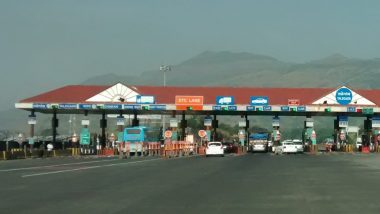New Delhi, July 26: The government is testing a new toll collection system using Global Navigation Satellite System (GNSS) technology on two national highways. The pilot study will be conducted on the Bengaluru-Mysore National Highway in Karnataka and the Panipat-Hisar National Highway in Haryana, as announced by Union Minister Nitin Gadkari in a written reply to the Rajya Sabha on Wednesday, July 24. Let's know what this new satellite-based toll collection system is and how it is different from FASTag.
Road Transport and Highways Minister Nitin Gadkari has announced that a GNSS-based Electronic Toll Collection (ETC) system will be tested on select sections of national highways in addition to the existing FASTag system. This new technology aims to enhance vehicle flow by enabling barrier-free tolling and distance-based charges, offering a smoother and more convenient experience for highway users. Satellite-Based Toll Collection System To Replace Toll Plazas, Says Transport Minister Nitin Gadkari (Watch Video).
What Is a Satellite-Based Toll System?
A satellite-based toll system charges vehicles for road use using satellite technology, often the Global Navigation Satellite System (GNSS). Vehicles with onboard units (OBUs) or tracking devices will have tolls based on the distance they travel. Digital image processing will capture location data, and software will calculate toll rates. CCTV cameras on gantries will oversee compliance, and payments will be automatically deducted from a digital wallet linked to the OBU for a smooth toll payment process. FASTag Update: Vehicles With Non-Affixed FASTag Have To Pay Double Fee at Toll Plazas on National Highways, Says NHAI.
How Is Satellite-Based Toll Collection System Different From FASTag?
A satellite-based toll system operates on the Global Navigation Satellite System (GNSS), which offers precise location tracking capability, unlike Fastag, which depends on physical booths. Although FASTag has sped up toll collection, queues during peak traffic hours remain an issue. GNSS technology aims to address this problem by providing a smooth, barrier-free commuting experience. Additionally, the GNSS system will work alongside the current FASTag system, ensuring a smooth transition for commuters from FASTags to GNSS technology.
(The above story first appeared on LatestLY on Jul 26, 2024 03:02 PM IST. For more news and updates on politics, world, sports, entertainment and lifestyle, log on to our website latestly.com).













 Quickly
Quickly












